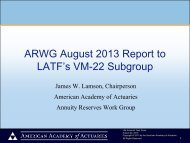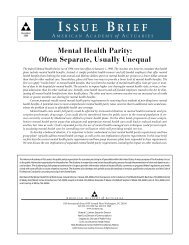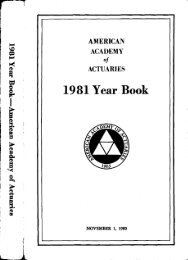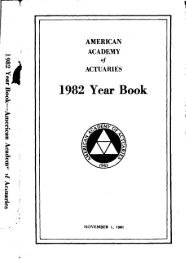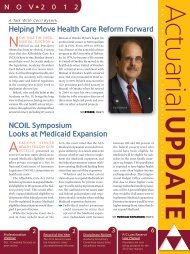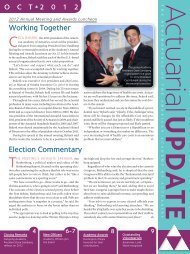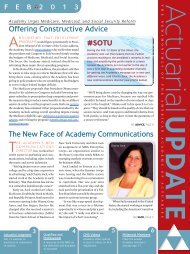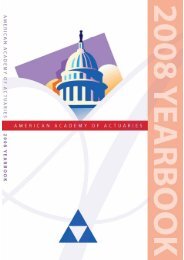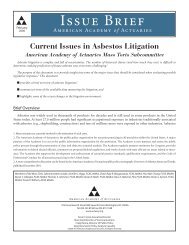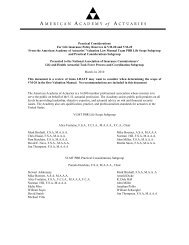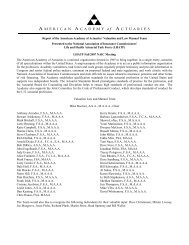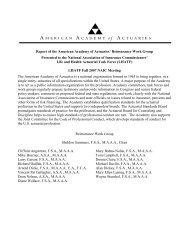Comments - American Academy of Actuaries
Comments - American Academy of Actuaries
Comments - American Academy of Actuaries
Create successful ePaper yourself
Turn your PDF publications into a flip-book with our unique Google optimized e-Paper software.
November 22, 2013<br />
Dave Sandberg, Chair<br />
Insurance Regulation Committee<br />
International Association <strong>of</strong> <strong>Actuaries</strong><br />
Re: IAA <strong>Comments</strong> on Common Framework for the Supervision <strong>of</strong> Internationally Active<br />
Insurance Groups (ComFrame)<br />
On behalf <strong>of</strong> the <strong>American</strong> <strong>Academy</strong> <strong>of</strong> <strong>Actuaries</strong>’ 1 Solvency Committee, I appreciate this<br />
opportunity to provide comments on the IAA’s Insurance Regulation Committee’s proposed<br />
comments on the IAIS ComFrame paper.<br />
Sincerely,<br />
R. Thomas Herget, FSA, CERA, MAAA<br />
Chairperson, Solvency Committee<br />
<strong>American</strong> <strong>Academy</strong> <strong>of</strong> <strong>Actuaries</strong><br />
1 The <strong>American</strong> <strong>Academy</strong> <strong>of</strong> <strong>Actuaries</strong> is 17,500-member pr<strong>of</strong>essional association whose mission is to serve the public and the<br />
U.S. actuarial pr<strong>of</strong>ession. The <strong>Academy</strong> assists public policy-makers on all levels by providing leadership, objective expertise<br />
and actuarial advice on risk and financial security issues. The <strong>Academy</strong> also sets qualification, practice and pr<strong>of</strong>essionalism<br />
standards for actuaries in the United States.<br />
1850 M Street NW Suite 300 Washington, DC 20036 Telephone 202 223 8196 Facsimile 202 872 1948 www.actuary.org
<strong>American</strong> <strong>Academy</strong> <strong>of</strong> <strong>Actuaries</strong>’ 1 Solvency Committee comments on ComFrame<br />
Paragraph ComFrame text Proposed IAA <strong>Comments</strong> <strong>Academy</strong> comments<br />
Reference<br />
General <strong>Comments</strong> General <strong>Comments</strong> Different sections require demonstrating or analyzing The committee 1 concurs<br />
some aspect <strong>of</strong> the company’s risk management. The<br />
document as written could imply a requirement for<br />
voluminous reporting that is duplicative <strong>of</strong> the ORSA.<br />
For example, some items listed that would likely be<br />
covered in an ORSA include – p. 46 Guideline M2E3-2-<br />
8-2, p. 48 Guideline M2E3-3-2-1, Guideline M2E3-3-6-<br />
1 and 2 p. 56 Guide M2E4-4-1-2 (U/Wing policy needs<br />
a feedback loop to ensure emerging risks are<br />
considered) p. 59 Par. M2E4-7-1 Reinsurance strategy<br />
should be in ORSA?<br />
General <strong>Comments</strong> General <strong>Comments</strong> One other unaddressed item that emerges is “What is The committee concurs<br />
appropriate and what are the consequences <strong>of</strong> failure?<br />
Some examples include p. 52 Parameter & Guideline<br />
M2E4-1-1 What is undue reliance? p. 53 Par. M2E4-1-3<br />
p. 56 Guideline M2E4-4-1-3 How to tell if reinsurance<br />
program exposes the balance sheet beyond its risk<br />
tolerance levels (actually seems redundant, seems to be<br />
written more like a notice to the regulator <strong>of</strong> what to<br />
consider). In any case, this is an area where the use <strong>of</strong><br />
actuarial standards and the IAIS requirements might be<br />
helpful. Also, as indicated in the notes, what will be the<br />
regulator tolerance for “failure” or weak compliance? In<br />
national jurisdictions, there are specific legal powers<br />
linked to instances <strong>of</strong> failure or weak compliance. But,<br />
since the IAIS standards to not have legal authority, the<br />
actuarial standards might be written to be more <strong>of</strong> a<br />
dialogue and focused on how to improve the company<br />
process no matter where the level <strong>of</strong> compliance exists.<br />
General <strong>Comments</strong> General <strong>Comments</strong> Lastly, the guidance seems silent on the specifics <strong>of</strong> a The committee concurs<br />
diversification credit – How will it be handled? It is<br />
referenced on p. 50 Guideline M2E3-4-1-2, but not<br />
described elsewhere and if (or how) it is allowed.<br />
General <strong>Comments</strong> General <strong>Comments</strong> No relevant IAA reference The IAIS document still includes<br />
1 “Committee” refers to the <strong>American</strong> <strong>Academy</strong> <strong>of</strong> <strong>Actuaries</strong> Solvency Committee<br />
1850 M Street NW Suite 300 Washington, DC 20036 Telephone 202 223 8196 Facsimile 202 872 1948 www.actuary.org 1
Introductory<br />
Remarks - 3.<br />
ComFrame<br />
Hierarchy<br />
Introductory<br />
Remarks - 6.<br />
Preconditions<br />
<strong>American</strong> <strong>Academy</strong> <strong>of</strong> <strong>Actuaries</strong>’ 1 Solvency Committee comments on ComFrame<br />
items in ComFrame Module 2 that are<br />
either already in the Insurance Core<br />
Principles (ICPs) or should be in the<br />
ICPs. A removal <strong>of</strong> this overlap<br />
would provide focus. The IAIS<br />
document contains several incidences<br />
<strong>of</strong> this overlap that the final drafting<br />
should remove.<br />
Guidelines illustrate practical No relevant IAA reference<br />
The ComFrame wording would imply<br />
approaches to implementing<br />
that guidelines should rarely include<br />
the standards and parameters,<br />
the word "should.” The subsequent<br />
provide more detail and show<br />
paragraphs are inconsistent in this<br />
how the requirements might<br />
regard. Some follow the concept <strong>of</strong><br />
be met.<br />
guidelines containing non-binding<br />
guidance and illustrations, while some<br />
include specific requirements. The<br />
document should make a consistent<br />
decision <strong>of</strong> the usage.<br />
To carry out the role <strong>of</strong> a<br />
group-wide supervisor as set<br />
out under Module 3,<br />
supervisors should have …<br />
powers and responsibilities to<br />
undertake group-wide<br />
supervision and supervisory<br />
cooperation<br />
No relevant IAA reference<br />
While the group-wide supervisory<br />
powers currently described in<br />
Module 3 do not rise to a level <strong>of</strong><br />
concern at this time, the potential<br />
for legal-entity limitations could<br />
become an issue should group<br />
supervision be defined to include<br />
extra-jurisdictional reach.<br />
ComFrame Supervisors identify whether No relevant IAA reference<br />
The committee is unsure how this<br />
Standard M1E1-1 or not a group qualifies as an<br />
would apply to a decentralized<br />
internationally active<br />
organization. For example, a company<br />
insurance group (IAIG).<br />
with underwriting operations that are<br />
completely decentralized and<br />
investment operations are centralized.<br />
Is this four groups (some <strong>of</strong> which<br />
may be IAIG and some not IAIGs)<br />
with common outsourcing, or one<br />
group? There may need to be some<br />
direction (via a parameter?) on how to<br />
handle this. [The Committee is aware<br />
1850 M Street NW Suite 300 Washington, DC 20036 Telephone 202 223 8196 Facsimile 202 872 1948 www.actuary.org 2
Parameter M1E2-1-<br />
2<br />
Parameter M2E1-1-<br />
1<br />
Guideline M2E1-1-<br />
1-3<br />
Guideline M2E1-1-<br />
1-4<br />
<strong>American</strong> <strong>Academy</strong> <strong>of</strong> <strong>Actuaries</strong>’ 1 Solvency Committee comments on ComFrame<br />
<strong>of</strong> other situations in which not all the<br />
insurance operations within a<br />
conglomerate were within the<br />
"insurance" division, hence Module 1<br />
should address this issue.]<br />
The group-wide supervisor No relevant IAA reference<br />
Should also require the group-wide<br />
documents the reasons for the<br />
supervisor to document the reasons for<br />
identification <strong>of</strong> the group as<br />
not identifying a group as an IAIG if it<br />
an IAIG<br />
would otherwise qualify based on the<br />
objective criteria in Element 1.<br />
The IAIG Pr<strong>of</strong>ile provides<br />
sufficient information to<br />
enable the IAIG to determine<br />
whether the legal and<br />
management structures give<br />
rise to any specific risks and<br />
demonstrate how such risks<br />
are mitigated.<br />
Matters which could give rise<br />
to such risks and need to be<br />
considered include: … the<br />
ability to restructure the IAIG<br />
during, or in response to,<br />
periods <strong>of</strong> stress.<br />
… Whatever structure is<br />
adopted, the IAIG should<br />
consider risks arising from:<br />
…<br />
The IAIG draws up<br />
contingency plans… to<br />
achieve a)acceptable financial<br />
condition and b) protection <strong>of</strong><br />
all policyholders<br />
No relevant IAA reference<br />
No relevant IAA reference<br />
No relevant IAA reference<br />
The discussion <strong>of</strong> risks and how they<br />
are mitigated would be better placed in<br />
M2E3 (ERM).<br />
The committee agrees that this is a<br />
major item for evaluating an IAIG's<br />
structure. The more intertwined the<br />
affiliate relationships within an IAIG,<br />
the fewer the options and the more<br />
difficult the rehabilitation in the event<br />
<strong>of</strong> a crisis.<br />
This would be better placed in M2E3<br />
(ERM).<br />
Parameter M2 E1-<br />
No relevant IAA reference<br />
This requirement as worded could lead<br />
2-1<br />
to action that detracts from the<br />
effective handling <strong>of</strong> problems. The<br />
risk is that detailed plans would be<br />
drawn up that would be inoperative in<br />
times <strong>of</strong> crisis (due to implicit<br />
assumptions about conditions during<br />
crisis that may not exist during such<br />
times). In general, the more detailed<br />
such plans are, the less useful they are.<br />
1850 M Street NW Suite 300 Washington, DC 20036 Telephone 202 223 8196 Facsimile 202 872 1948 www.actuary.org 3
Guideline M2E1-2-<br />
2-1<br />
Parameter M2 E2-<br />
11<br />
ComFrame<br />
Standard M2E1-3<br />
<strong>American</strong> <strong>Academy</strong> <strong>of</strong> <strong>Actuaries</strong>’ 1 Solvency Committee comments on ComFrame<br />
The focus/guidance should be on<br />
clearly identifying authority and<br />
responsibility, including backups, and<br />
identifying a range or categories <strong>of</strong><br />
options.<br />
… The IAIG outlines what<br />
management actions it would<br />
take to manage the potential<br />
cash flow implications <strong>of</strong> a<br />
stress scenario …<br />
The supervisor requires that<br />
there is an effective actuarial<br />
function capable <strong>of</strong><br />
evaluating and providing<br />
advice to the insurer<br />
regarding, at a minimum,<br />
technical provisions,<br />
premium and pricing<br />
activities, and compliance<br />
with related statutory and<br />
regulatory requirements.<br />
The IAIG takes account <strong>of</strong><br />
the policyholder protection<br />
schemes (PPS) that apply to<br />
its insurance entities, and how<br />
these schemes affect each <strong>of</strong><br />
the entities in the IAIG.<br />
No relevant IAA reference<br />
What is effective? Link to E4 8 What is the<br />
consequence if it is deemed not effective?<br />
No relevant IAA reference<br />
Should change "would" to "could.” A<br />
contingency plan should not overly<br />
restrict management's options nor<br />
commit them to a single course <strong>of</strong><br />
action in a time <strong>of</strong> crisis, as every<br />
crisis is different. It is impossible to<br />
predict in advance what the<br />
environment will be like.<br />
The committee concurs<br />
The committee is unsure why this is<br />
needed in ComFrame. It does not<br />
seem to be material enough to mention<br />
separately. It should be in an ICP. If<br />
it is material for an IAIG, then it<br />
would be applied in the IAIG's ERM<br />
(under Module 3).<br />
This would be better placed in the<br />
Element 3 (ERM) rather than Element<br />
2 (Governance).<br />
Parameter M2E2-1- The IAIG’s group-wide No relevant IAA reference<br />
1<br />
governance framework is<br />
well documented and<br />
contains adequate measures<br />
to: address risks arising<br />
from or affecting the IAIG<br />
Guideline M2E2-2- The Governing Body should No relevant IAA reference The only thing that seems to be<br />
1850 M Street NW Suite 300 Washington, DC 20036 Telephone 202 223 8196 Facsimile 202 872 1948 www.actuary.org 4
3-1 undertake, at least annually,<br />
an assessment <strong>of</strong> how the<br />
IAIG, the Governing Body<br />
and the Senior Management<br />
meet the performance goals<br />
and measures adopted.<br />
<strong>American</strong> <strong>Academy</strong> <strong>of</strong> <strong>Actuaries</strong>’ 1 Solvency Committee comments on ComFrame<br />
different here from the ICPs is the<br />
requirement for an annual review.<br />
According to the hierarchy in the<br />
Introductory Remarks, such a<br />
requirement should be in the<br />
parameter and not in a guideline.<br />
ComFrame<br />
Standard M2E2-4<br />
Guideline M2E2-5-<br />
1-1<br />
"The supervisor requires the<br />
insurer’s Board to have, on an<br />
on-going basis: an<br />
appropriate number and mix<br />
<strong>of</strong> individuals …, appropriate<br />
internal governance practices<br />
and procedures …, adequate<br />
powers and resources<br />
The group-wide remuneration<br />
policy may have a structure<br />
which contains elements <strong>of</strong><br />
group-wide and entity based<br />
remuneration policies and<br />
practices. …<br />
No relevant IAA reference<br />
No relevant IAA reference<br />
The parameters and guidelines that<br />
accompany this standard seem to be<br />
rather general and not unique to<br />
IAIGs. Therefore, the committee does<br />
not see the need for this section in<br />
ComFrame.<br />
There is no mention in this guideline<br />
about conflicts between group-wide<br />
versus individual entity incentives, but<br />
suggest there probably should be.<br />
Guideline M2E2-<br />
11-1-1<br />
The IAIG’s group-wide<br />
actuarial function should<br />
aggregate and review<br />
actuarial information at the<br />
group level. The form and<br />
implementation <strong>of</strong> a groupwide<br />
actuarial function may<br />
vary but the outcome is to<br />
have an overview <strong>of</strong> the<br />
actuarial activities, functions<br />
and risks <strong>of</strong> the insurers<br />
within the IAIG as a whole.<br />
Further examples <strong>of</strong> activities<br />
that could be carried out by<br />
the IAIG's actuarial function<br />
include providing advice and<br />
opinion on…<br />
No relevant IAA reference<br />
Suggest modifying: “The IAIG’s<br />
group-wide actuarial function should<br />
include aggregation and review <strong>of</strong><br />
actuarial information at the group<br />
level...”<br />
Guideline M2E2-<br />
No relevant IAA reference<br />
It is clear that these are examples, but<br />
11-1-2<br />
would be better if “advice and<br />
opinion" were replaced by "advice,<br />
opinion, or report." In the U.S., an<br />
"opinion" may imply a legal<br />
1850 M Street NW Suite 300 Washington, DC 20036 Telephone 202 223 8196 Facsimile 202 872 1948 www.actuary.org 5
<strong>American</strong> <strong>Academy</strong> <strong>of</strong> <strong>Actuaries</strong>’ 1 Solvency Committee comments on ComFrame<br />
attestation to compliance with legal<br />
provisions.<br />
Parameter M2E2-<br />
13-1<br />
The IAIG has a consistent<br />
group-wide policy for the<br />
outsourcing <strong>of</strong> activities or<br />
functions, and retains<br />
appropriate documentation<br />
for all such outsourcing. It<br />
should be accountable at a<br />
group level for its outsourcing<br />
activities in order to provide<br />
control over the process and<br />
effectively aggregate the<br />
impact they may have on<br />
group-wide ERM policy.<br />
No relevant IAA reference<br />
The scope <strong>of</strong> this parameter is<br />
expansive. As worded, it would<br />
include outsourcing <strong>of</strong> the employee<br />
cafeteria, grounds maintenance, and<br />
other administrative areas with low<br />
risk. The committee recommends that<br />
it be reworded to require such controls<br />
for areas with a potentially material<br />
impact on solvency and viability risks.<br />
Note: Accompanying guideline also<br />
says to "provide for group-wide<br />
monitoring and oversight <strong>of</strong> the<br />
outsourced (intra-group or external)<br />
activities.” This is burdensome for<br />
some administrative functions.<br />
Standard M2E3-1<br />
The supervisor requires the<br />
insurer’s enterprise risk<br />
management framework to<br />
provide for the identification<br />
and quantification <strong>of</strong> risk<br />
under a sufficiently wide<br />
range <strong>of</strong> outcomes using<br />
techniques which are<br />
appropriate to the nature,<br />
scale and complexity <strong>of</strong> the<br />
risks the insurer bears and<br />
adequate for risk and capital<br />
management and for solvency<br />
purposes.<br />
Who decides what is or is not appropriate? Is this<br />
defined elsewhere?<br />
The committee recommends the IAA<br />
not include in its response a comment<br />
on a direct quotation from an ICP.<br />
Standard M2E3-1<br />
The IAIG has a group-wide<br />
ERM Framework that<br />
addresses all relevant and<br />
material risks at both the<br />
insurance entity and IAIG<br />
Including that <strong>of</strong> unknown risks via an emerging risk<br />
process.<br />
The committee concurs<br />
1850 M Street NW Suite 300 Washington, DC 20036 Telephone 202 223 8196 Facsimile 202 872 1948 www.actuary.org 6
Standard M2E3-1<br />
Parameter M2E3-1-<br />
2<br />
Parameter M2E3-1-<br />
4<br />
<strong>American</strong> <strong>Academy</strong> <strong>of</strong> <strong>Actuaries</strong>’ 1 Solvency Committee comments on ComFrame<br />
level and enables the IAIG to<br />
assess its solvency<br />
requirements.<br />
The IAIG has a group-wide<br />
ERM Framework that<br />
addresses all relevant and<br />
material risks at both the<br />
insurance entity and IAIG<br />
level and enables the IAIG to<br />
assess its solvency<br />
requirements.<br />
The IAIG comprehensively<br />
documents its ERM<br />
Framework, emphasizing any<br />
differences that may apply to<br />
different entities within the<br />
IAIG, due to the nature, scale<br />
and complexity <strong>of</strong> the<br />
business conducted locally.<br />
The IAIG’s ERM Framework<br />
is independently reviewed on<br />
a regular basis, at least once<br />
every three years, in order to<br />
ascertain that the ERM<br />
Framework itself remains fit<br />
for purpose.<br />
No relevant IAA reference<br />
No relevant IAA reference<br />
What does it mean to be “fit for purpose”? Since the<br />
guideline says the review may be carried out by others,<br />
how will the reviewers know how to evaluate it?<br />
This document should address how<br />
non-insurance entity risk is to be<br />
addressed.<br />
It seems that this would be more<br />
appropriate for an ICP itself, as long<br />
as an ICP would include a requirement<br />
to emphasize the differences between<br />
the risks as they apply to entities<br />
within an IAIG. While ComFrame<br />
may be trying to get additional<br />
comparative comments into the ERM<br />
documentation, this request might be<br />
better appearing in an ICP rather than<br />
ComFrame itself.<br />
The committee agrees with the<br />
comment and would further pose<br />
another question, what are the<br />
reviewers independent <strong>of</strong>?<br />
Guideline M2E3-1- The review may be carried Is the outcome <strong>of</strong> the review a “clean bill <strong>of</strong> health” or a The committee agrees with the<br />
4-1<br />
out by an internal or external list <strong>of</strong> red, yellow, green comments or a “What is comment and suggests removing the<br />
body but the independent working well and what needs to be better?”<br />
word "independent" here. Since the<br />
reviewer should not be<br />
reviewer may be in the employ <strong>of</strong> the<br />
responsible for, nor have been<br />
IAIG, they are not "independent" in<br />
actively involved in, the part<br />
the usual context <strong>of</strong> the word (e.g.,<br />
<strong>of</strong> the ERM Framework that<br />
"independent auditor").<br />
it reviews.<br />
Parameter M2E3-1- The IAIG articulates its risk My highlights – What examples (and pr<strong>of</strong>essional The committee concurs<br />
1850 M Street NW Suite 300 Washington, DC 20036 Telephone 202 223 8196 Facsimile 202 872 1948 www.actuary.org 7
<strong>American</strong> <strong>Academy</strong> <strong>of</strong> <strong>Actuaries</strong>’ 1 Solvency Committee comments on ComFrame<br />
6 appetite by establishing and literature or notes) are there about qualitative risk<br />
maintaining a risk tolerance tolerances? Qualitative is also used on p. 45 in<br />
statement for the group Parameter M2E3-2-8<br />
which:<br />
• sets out its overall<br />
qualitative and quantitative<br />
risk tolerance and<br />
• defines risk tolerance limits<br />
that take into account all<br />
relevant and material risk,<br />
both on an insurance entity<br />
and group wide basis.<br />
Standard M2E3-2<br />
Parameter M2E3-2-<br />
1<br />
Within the group-wide ERM<br />
Framework, the IAIG<br />
develops a comprehensive<br />
group-wide ERM policy<br />
which addresses the risks on<br />
both an insurance entity and<br />
group-wide basis.<br />
Through its group-wide ERM<br />
policy, the IAIG defines the<br />
basis for how it determines<br />
the relationship between the<br />
IAIG’s risk tolerance limits,<br />
regulatory capital<br />
requirements, economic<br />
capital and the processes and<br />
methods for monitoring risk.<br />
Who decides whether it does or does not address it?<br />
What is the consequence if it is not addressed?<br />
No relevant IAA reference<br />
It may not be needed as it seems the<br />
group-wide supervisor addresses this.<br />
This sentence is confusing and we<br />
suggest it should be rewritten for<br />
greater clarity: “During the<br />
development, statement and testing <strong>of</strong><br />
its group-wide ERM policy, the IAIG<br />
both defines the basis for how it<br />
determines the relationships among<br />
the IAIG’s risk tolerance limits,<br />
regulatory capital requirements, and<br />
economic capital and also formalizes<br />
the processes and methods for<br />
monitoring risk.”<br />
Standard M2E3-3-1 The framework covers at least No relevant IAA reference<br />
Since this seems to be a<br />
the following risks:<br />
comprehensive list, consider adding<br />
insurance, etc.<br />
"counterparty risk". Counterparties<br />
are cited in the guideline, M2E3-3-1-2,<br />
that follows.<br />
Guideline M2E3-4- In conducting its ORSA, the Are these different from, contained within or in addition “counterparty risk” should be included<br />
1850 M Street NW Suite 300 Washington, DC 20036 Telephone 202 223 8196 Facsimile 202 872 1948 www.actuary.org 8
4-1 IAIG should consider risks<br />
arising from insurance and<br />
other entities, including nonregulated<br />
ones.<br />
Some other risks that are<br />
important to consider are:<br />
• liquidity risk<br />
• strategic risk<br />
• reputational risk<br />
Guideline M2E4-2-<br />
4-1<br />
Parameter M2E4-8-<br />
2<br />
Parameter M2E4-8-<br />
2<br />
<strong>American</strong> <strong>Academy</strong> <strong>of</strong> <strong>Actuaries</strong>’ 1 Solvency Committee comments on ComFrame<br />
to the operational risks mentioned in the accompanying<br />
Parameter<br />
The IAIG should also have<br />
documented procedures on<br />
actions to be taken to affect<br />
the cross-border transfer <strong>of</strong><br />
capital and assets in normal<br />
and stressed times.<br />
The group-wide actuarial<br />
policy requires an annual<br />
actuarial opinion (whether<br />
certified or not) to be<br />
provided to the Governing<br />
Body. This actuarial opinion<br />
is forward looking and goes<br />
beyond the current balance<br />
sheet <strong>of</strong> the IAIG. It covers at<br />
least the following subjects:<br />
• the reliability and<br />
sufficiency <strong>of</strong> the technical<br />
provisions<br />
• the adequacy <strong>of</strong> reinsurance<br />
credit for technical provisions<br />
The actuarial opinion<br />
includes consideration <strong>of</strong><br />
non-insurance entities and<br />
Will this link to Module 3 on the supervisory need to<br />
have similar documentation/preapproval already in<br />
place? This will be <strong>of</strong> little value if regulators will not<br />
allow the actions in a time <strong>of</strong> stress.<br />
Reliability and sufficiency will need to be defined to be<br />
sure they are applied consistently. This will not be the<br />
same as local unit statutory sufficiency if only the<br />
central estimate is booked in the consolidated balance<br />
sheet (without any risk margins).<br />
Is this a well-defined, limited role or can they rely on<br />
another expert?<br />
The committee concurs<br />
In addition, the term "opinion" should<br />
be replaced with "report."<br />
In addition, the term "opinion" should<br />
be replaced with "report."<br />
non-regulated entities.<br />
Parameter M2E4-8- The actuarial opinion Will need to distinguish if and how the purpose <strong>of</strong> an The committee concurs<br />
2<br />
includes consideration <strong>of</strong> actuarial opinion differs from an accounting opinion.<br />
non-insurance entities and Direction is needed to clarify if desired outcome is a<br />
non-regulated entities. “clean” opinion, or is more like an assessment/report on<br />
1850 M Street NW Suite 300 Washington, DC 20036 Telephone 202 223 8196 Facsimile 202 872 1948 www.actuary.org 9
<strong>American</strong> <strong>Academy</strong> <strong>of</strong> <strong>Actuaries</strong>’ 1 Solvency Committee comments on ComFrame<br />
green, yellow, red.<br />
Parameter M2E4-8-<br />
2<br />
The actuarial opinion<br />
includes consideration <strong>of</strong><br />
non-insurance entities and<br />
non-regulated entities.<br />
Based on US meaning <strong>of</strong> opinion, the actuary could not<br />
opine on non-insurance or non-regulated entities.<br />
The committee concurs<br />
Parameter M2E4-8-<br />
2<br />
The actuarial opinion<br />
includes consideration <strong>of</strong><br />
non-insurance entities and<br />
non-regulated entities.<br />
ComFrame is insurance only. These are only relevant to<br />
SIFI‘s. Expectation <strong>of</strong> this topic? Can the actuary point<br />
out the issues without needing to evaluate/quantify the<br />
risk? Are they advising the board or providing<br />
assurance/reliance to the board?<br />
The committee concurs<br />
Guideline M2E4-8-<br />
2-1<br />
Guideline M2E4-8-<br />
2-1<br />
The IAIG may use the<br />
underlying actuarial reports<br />
submitted locally by the<br />
individual insurance entities<br />
as input to its annual actuarial<br />
opinion to the Governing<br />
Body.<br />
the methodologies used to<br />
determine the margin over<br />
current estimate (MOCE)s by<br />
each insurance entity and the<br />
consolidation/aggregation<br />
method applied at the group<br />
level<br />
Is the input an opinion as a statement <strong>of</strong> reliance to the<br />
board, or a documentation <strong>of</strong> current procedures,<br />
shortcomings and plans for improvement? How much<br />
would be duplicated in the ORSA? Or can be left out <strong>of</strong><br />
the ORSA if included here?<br />
The MOCE’s are not expected to be calculated, used or<br />
determined for the ComFrame balance sheet. All <strong>of</strong> the<br />
Margins will be in the capital.<br />
The committee concurs<br />
The committee concurs<br />
Guideline M2E4-8-<br />
2-1<br />
Suitability and adequacy <strong>of</strong><br />
reinsurance/risk transfer<br />
arrangements taking into<br />
account the strategies for<br />
underwriting and claims<br />
management as well as the<br />
overall financial condition <strong>of</strong><br />
the IAIG and the Governing<br />
Body's risk tolerance.<br />
Is this last item meant to include a requirement to opine<br />
on the opinions <strong>of</strong> the other mentioned functions &<br />
policies? How likely would this duplicate an ORSA or<br />
could be done here vs. the ORSA?<br />
The committee concurs<br />
1850 M Street NW Suite 300 Washington, DC 20036 Telephone 202 223 8196 Facsimile 202 872 1948 www.actuary.org 10
Standard M2E5-1<br />
<strong>American</strong> <strong>Academy</strong> <strong>of</strong> <strong>Actuaries</strong>’ 1 Solvency Committee comments on ComFrame<br />
The IAIG assesses its capital Will it also compare fungibility? Via stress testing??? The committee concurs<br />
adequacy by comparing its<br />
qualifying capital resources to<br />
the capital benchmark.<br />
Standard M2E5-2<br />
For the purposes <strong>of</strong> the<br />
capital adequacy assessment,<br />
the IAIG applies a total<br />
balance sheet approach to<br />
assess all the material risks to<br />
which it is exposed.<br />
Next step is more details on total balance sheet approach<br />
– Will it include/exclude deferred taxes, etc.?<br />
The committee concurs<br />
Parameter M2E5-5-<br />
2<br />
Standard M2E5-6<br />
The IAIG's financial<br />
instruments that qualify as<br />
core capital do not have a<br />
fixed maturity.<br />
The IAIG assesses the ability<br />
<strong>of</strong> its capital elements, other<br />
than financial instruments, to<br />
absorb losses on both a<br />
going-concern and wind-up<br />
basis.<br />
No relevant IAA reference<br />
How is this demonstrated?<br />
Surplus notes should be a component<br />
<strong>of</strong> core capital even though they have<br />
a fixed maturity.<br />
The committee concurs<br />
Standard M2E5-7<br />
Parameter M2E5-7-<br />
4<br />
The IAIG’s amount <strong>of</strong><br />
qualifying capital resources is<br />
determined after the<br />
application <strong>of</strong> inclusions and<br />
exclusions to reflect that<br />
some capital elements’ basis<br />
<strong>of</strong> valuation or recognition<br />
may not be appropriate for<br />
capital adequacy assessment.<br />
The IAIG includes in its<br />
additional capital … the<br />
DTA's… in a winding-up<br />
How is the appropriateness determined?<br />
No relevant IAA reference<br />
The committee concurs<br />
We believe this would be an<br />
acceptable resource in a going concern<br />
test.<br />
Standard M2E5-8<br />
The IAIG determines the<br />
amount <strong>of</strong> its qualifying<br />
What does this mean?<br />
The committee concurs<br />
1850 M Street NW Suite 300 Washington, DC 20036 Telephone 202 223 8196 Facsimile 202 872 1948 www.actuary.org 11
<strong>American</strong> <strong>Academy</strong> <strong>of</strong> <strong>Actuaries</strong>’ 1 Solvency Committee comments on ComFrame<br />
capital resources subject to<br />
limits.<br />
Standard M2E5-11<br />
Standard M2E5-12<br />
Standard M2E5-13<br />
Parameter M3E1-2-<br />
6<br />
In determining the group<br />
capital benchmark, the IAIG<br />
addresses the key categories<br />
<strong>of</strong> risk (including risk<br />
concentrations) which are:<br />
insurance risk, market risk,<br />
credit risk, group risk and<br />
operational risk.<br />
The IAIG, for the purposes <strong>of</strong><br />
calculating its group capital<br />
benchmark, uses a scenariobased<br />
approach.<br />
The IAIG combines the<br />
results <strong>of</strong> the different<br />
components <strong>of</strong> the scenariobased<br />
approach in line with<br />
the target criteria in order to<br />
obtain a group-wide capital<br />
benchmark.<br />
The group-wide supervisor<br />
assesses the valuation and<br />
capital adequacy <strong>of</strong> the IAIG,<br />
as well as its leverage and<br />
liquidity.<br />
How does it demonstrate that these items have been<br />
addressed? Is it implicit or explicit that operational risk<br />
(and other similar risks) need capital?<br />
What is a scenario based approach? Own capital<br />
benchmark or regulator defined benchmark?<br />
STANDARD NEEDS TO LINK TO THIS AND WILL<br />
NEED INPUT TO BE REVIEWED IN FTTF Project.<br />
Company discretion allowed?<br />
What criteria are used to “assess”? Is leverage based on<br />
total capital or free capital? Setting liabilities at central<br />
estimates will portray a less leveraged balance sheet<br />
even though the risks are unchanged.<br />
The committee concurs<br />
The committee concurs<br />
The committee concurs<br />
The committee concurs<br />
1850 M Street NW Suite 300 Washington, DC 20036 Telephone 202 223 8196 Facsimile 202 872 1948 www.actuary.org 12



